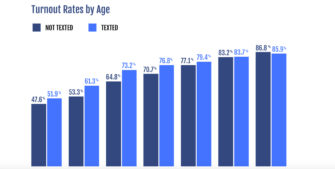Learning from Politics: Texting
In the last US election year, we talked about what we can learn from political campaigns in hypertargeting, nudge language, and building the tools you need. Now, we have a lesson we can take from the 2018 cycle about the use of texting.
A bit of background – for political campaigns, robocalls are the incumbent way to turn people out at the polls. But they are facing the same challenges also experienced by regular phone. Namely, people don’t answer their phone. And who can blame them, when we are getting an average of 15 robocalls per month.
So, Tech for Campaigns ran texting campaigns for a number of candidates. In all, they were able to aggregate data from 20 states, 29 texting programs, and over a million texts. They warn here the data are correlational, not causal, as setting up a control is difficult.
Texting was related to a one percentage point increase in turning out at the polls:
Which, as they point out, is significant in races that can be decided by mere hundreds of votes.
But the effect wasn’t uniform. Younger people (under 50 years old) saw increases of 4-8 percentage points, with little-to-no effect among those older:
 Wait, you say! The Agitator is making an argument that demographics are a useful way to segment people for understanding? What’s next? Will you Agitators argue that we’re better off relying on Facebook’s first party data (that makes them a bazillion dollars a year…) rather than building out our own first party data (beyond donor giving behavior with your organization)?
Wait, you say! The Agitator is making an argument that demographics are a useful way to segment people for understanding? What’s next? Will you Agitators argue that we’re better off relying on Facebook’s first party data (that makes them a bazillion dollars a year…) rather than building out our own first party data (beyond donor giving behavior with your organization)?
Don’t worry, it isn’t a sign of the apocalypse or anarchy or other major change at The Agitator because, as it turns out, demographics continue to be lousy at understanding why people do what they do compared to factors that cut across demographic groups.
In this case, people who got text messages about the issue(s) they cared about were 8.2% more likely to vote. This was far more effective than messages about non-issue-based texts (that talked about voting hours, poll locations and such). And it held true regardless of age, party, voting history, etc. etc.
Once again, “why” trumps demographic “who’s” and “when”, “where”, or “how”. And lots better when the “why” is tied to the voter’s “why” – some people would reduce this need down to a call for content to be “relevant” (as if someone is arguing for irrelevant content?) and leave it at that.
It is worth underscoring that to match a charity “why” to a donor’s “why” and do it well requires knowing the latter at the individual supporter level and here we come full-circle to an organization’s need for first party data that goes beyond the where, when and how of donor behavior (we’ve written about this here).
In summary, texting can work to get people to act on timely issues. But like all other communications, it’s better off if it is tied to the recipient’s “why” for acting.
Any stories from text campaigns in the nonprofit realm out there?
Kevin



Completely off topic:
I received an appeal in yesterday’s mail (Jan. 7) for a Conservation International matching gift offer boldly subheaded “DEADLINE: DECEMBER 31st”.
The letter was dated December 9.
Client, printer, mailing house or postal service error? Or does everyone get to share the shame?